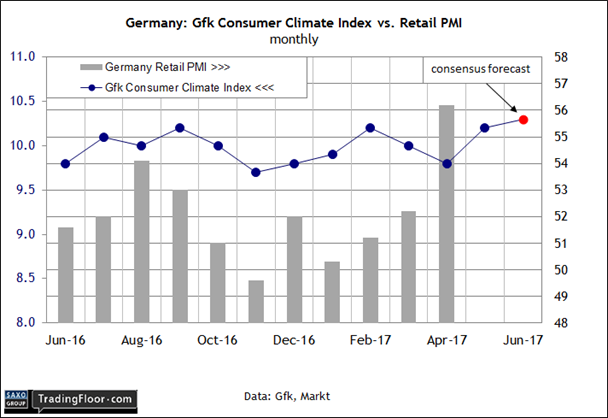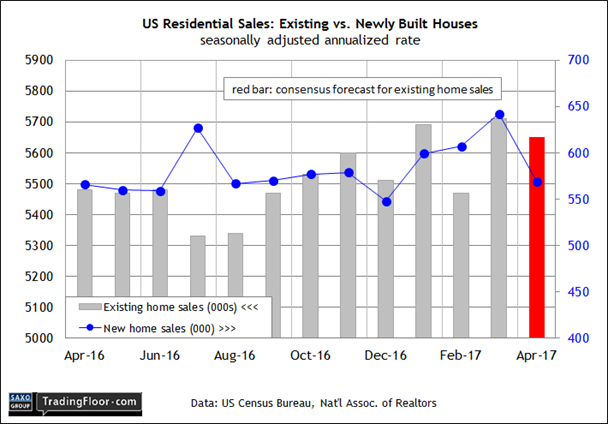- Germany’s Gfk Consumer Climate Index looks set to edge up to a 16-year high
- Existing home sales in the US to dip in April, following a drop in new-home sales
- The 2-year Treasury yield drifting, despite expectations for a rate hike
Germany’s robust economy is in the spotlight again today, with the monthly update of the Gfk Consumer Climate Index.
Later, we’ll see the April report on US existing home sales. In the meantime, keep an eye on the policy sensitive two-year yield, which has been surprisingly quiescent lately in light of expectations for a rate hike by the Fed next month.
Germany
Gfk Consumer Climate Index (0600 GMT): Yesterday’s update on sentiment data in May for Europe’s biggest economy delivered stronger-than-expected news. Is that a sign that the outlook for German economic growth deserves to be revised up?
The question resonates in the wake of Monday’s release of the Finance Ministry’s monthly report, which predicted that the firmer macro trend in this year’s first quarter would slow a bit for the rest of the year. But Tuesday’s upbeat survey numbers suggest otherwise.
The flash data for the Germany PMI Composite Index in May perked up to 57.3, reflecting a healthy growth rate for country.
The increase “signalled no let-up in German economic growth, with the headline output index reaching its highest level in over six years”, said an IHS Markit economist.
Meanwhile, the Ifo Business Climate Index rose more than expected in May, touching a record high. “The mood among German business was euphoric in May,” the president of the Ifo Institute noted.
The bullish data suggests that today’s report on consumer sentiment will echo the optimistic outlook.
Econoday.com’s consensus forecast sees the Gfk Consumer Climate Index ticking up to 10.3 for what’s labeled as the June forecast.
That’s only a fractional improvement from May’s 10.2, but if the prediction is right the benchmark will reach its highest level since 2001.

The United States
Existing Home Sales (1400 GMT): Sales of newly constructed houses fell more than expected in April, dropping by the most in two years.
Today’s update on sales of existing homes will be widely read for clues on whether yesterday’s bigger-than-expected slide carries implications for the housing market generally.
The initial reaction by some economists is that the sharp fall in new-home sales in April is a one-off event, largely a reaction to March’s gain, which lifted transactions to a post-recession high.
“We expect sales to rebound somewhat in May, and to return to the March high, at least, over the next few months,” advised the chief economist at Pantheon Macroeconomics.
A key factor that supports the forecast: healthy labour market growth.
Payrolls rebounded last month with moderate growth, easing concern that March’s weak gain was the start of trouble for the US economy. As the ranks of the employed swell, the appetite for housing tends to follow.
Economists expect that sales of existing homes – a much-bigger market compared with new homes - will dip in today’s April report, but only modestly after touching a post-recession high in March.
Econoday.com’s consensus forecast calls for a decline to 5.65 million units (seasonally adjusted annual rate), down from 5.71 million previously.
A significantly bigger-than-expected fall would raise questions about the outlook for the housing market.
Yet with employment still growing at a solid pace it would take more than a couple of disappointing updates on sales to materially darken the near-term forecast.

US 2-Year Yield: The US economic outlook continues to look encouraging, but you wouldn’t know by looking at Treasury yields lately.
The policy sensitive two-year yield in particular has fallen slightly from its recent peak of 1.35%, dipping to 1.30% at mid-day trading on Tuesday.
That’s a modest slide, but it’s somewhat surprising given that economic growth appears to be picking up and the crowd expects that the Federal Reserve will lift interest rates next month, building on the 75-basis-point increase that’s unfolded since December 2015.
Fed funds futures are currently estimating an implied 83% probability that the central bank will squeeze monetary policy at the June 13-14 Federal Open Market Committee meeting, based on CME data.
Yet comments from some Fed officials have struck a dovish tone lately. St Louis Fed President James Bullard on Friday said the schedule of expectations for higher rates may be “too aggressive”.
Perhaps today’s release of Fed minutes for the May 2-3 policy meeting – scheduled for 1800 GMT -- will clarify the outlook.
The broad trend, however, suggests that another round of tightening is near.
The Chicago Fed National Activity Index, a measure of US economic activity, jumped to a three-year high last month, signalling solid growth for the near term.
Meantime, economists expect that second quarter GDP growth for the US will post a sharp rebound, based on a variety of forecasts.
The two-year yield, in other words, looks surprisingly soft, given the outlook. Short of a batch of deeply disappointing economic reports in the days ahead, it’s reasonable to expect that Treasury yields generally, and the two-year rate in particular, will drift higher ahead of next month’s policy announcement.

Disclosure: Originally published at Saxo Bank TradingFloor.com
